In a city as crowded and entropic as Philadelphia, it is easy to feel powerless. We are constantly struggling to balance our own internal jurisdiction with external authorities and often find ourselves asking, “Who approved that?” or “They should’ve asked me!” Featuring work by artists Stuart Elster and Peter Krashes, the current exhibit in Gallery 102 focuses specifically on the dual nature of power and the battle between its personal and public perceptions.
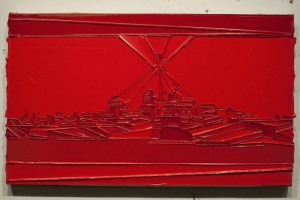
Though similar in theme and eye-catching color scheme, the gouache and oil paintings of each of these men differ in their relationship to “power.” Stuart Elster takes a cultural approach to the subject and gathers inspiration from popular images found in the public consciousness. Stock images of iconographic items include coins, war ships and fashion labels. These images act as universal models of power for Elster’s paintings and he uses thick layers of paint to create his bold and textural pieces.
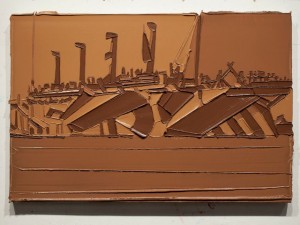
Most common among Elster’s works are bright, monochromatic paintings of World War I dazzle ships. According to curator Rebecca Saylor Sack, dazzle camouflage was a technique used by the Navy whereby the ships were painted with complex geometric patterns in order to confuse the opposition. These striking combinations of shapes worked to distort the visual clues used by the enemy to estimate distance from their target. The technique inhibited enemy accuracy when firing missiles. In his paintings “In Dazzle Red” and “In Dazzle Brown,” Elster subverts the hulking power of these war vessels by painting them in luscious, Candy Land colors and applying the paint in thick, icing-like stripes. The effect makes the pieces truly lick-able (though I wouldn’t recommend it) and turns these popular images of deception, war and empowerment into something disconcertingly delicious.
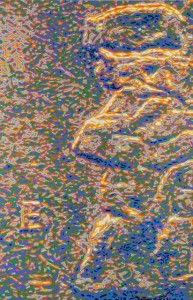
“Live Free or Die” is the most striking Elster piece for both its color and size. The image represents the Old Man of the Mountain, an iconic symbol of New Hampshire (a natural rock formation in a New Hampshire mountain that resembles the profile of an old man). The Old Man of the Mountain is also found on the state’s quarter. Broken up into many small, technicolored shapes, the pattern of this piece is reminiscent of the dazzle camouflage and overwhelming in its visual complexity — a fact that unfortunately doesn’t translate to photography. It is interesting to note that the Old Man of the Mountain collapsed in 2003. As a representation of currency, “Live Free or Die” comments on the power of an image and how its influence pervades after the place or object is gone.
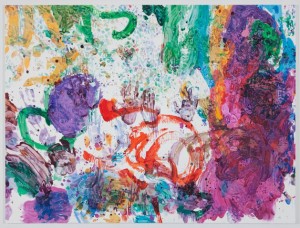
Unlike Elster, Krashes searches for his images of power within himself and bases his work on experiences he has had as a community organizer in Brooklyn. His piece “Summer Streets” is inspired by a personal photo he captured during a political rally. Dissimilar to the preceding pieces by Elster, “Summer Streets” stands alone in its lack of geometry. The painting is loud and chaotic in its composition but it speaks to power as something that can inspire quiet introspection.
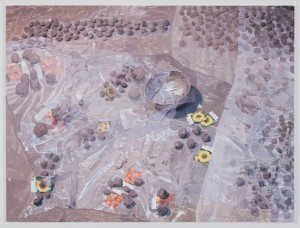
“Seed Bomb Factory” is another piece based on the artist’s personal political life. It depicts guerilla gardening which is popular in urban areas. The color palette of this piece is much softer and calmer than that of “Summer Streets.” A more traditional painting, the intent of “Seed Bomb Factory” is more glaring as it signifies the potential of the people to inspire both literal and metaphoric growth. In the context of the show, it symbolizes the power of community.
Overall, the show is vibrant and visually stimulating. I found that it was interesting to track and observe the narrative of power from both a personal and public point of view. At times, it seemed as though the overall notion of power was lost to each individual piece’s story but overall, the exhibit is successful in conveying its message.
Elster/Krashes will be on display in Gallery 102 at Crane Arts until February 2, with a closing reception Saturday, Feb. 2, 4-6pm.
All images are courtesy of Rebecca Saylor Sack.
–Ali Blum graduated from the University of Pennsylvania in May of 2012 with a degree in Classical Civilizations. She currently acts as the editor and social media intern at theartblog.org and continues to pursue her dream of working in the art world. Follow her and the rest of theartblog.org on Twitter for more of your favorite updates @theartblog!






